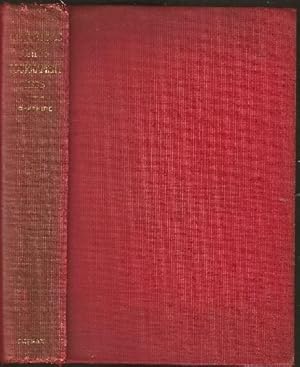Horace Fabian Cheshire Editor Inscribed (1 results)
Product Type
- All Product Types
- Books (1)
- Magazines & Periodicals
- Comics
- Sheet Music
- Art, Prints & Posters
- Photographs
- Maps
-
Manuscripts &
Paper Collectibles
Condition
- All Conditions
- New
- Used
Binding
- All Bindings
- Hardcover
- Softcover
Collectible Attributes
- First Edition
- Signed
- Dust Jacket
- Seller-Supplied Images
- Not Printed On Demand
Seller Location
Seller Rating
-
The Hastings Chess Tournament 1895, Containing the Authorised Account of the 230 Games Played Aug.-Sept. 1895 with Annotations . And Biographical Sketches of the Chess Masters
Published by Chatto & Windus and G P Putnam's Sons, London and New York, 1896
Seller: The Book Collector, Inc. ABAA, ILAB, Fort Worth, TX, U.S.A.
Book First Edition
Hardcover. Condition: Very Good. 1st Edition. xii+370+[32 ad] pages with frontispiece and 21 additional plates. Small octavo (7 3/4" x 5 1/4") bound in original publisher maroon patterned cloth with gilt lettering to spine. Containing the authorized account of the 230 games played Aug.-Sept. 1895 with annotations by Pillsbury, Lasker, Tarrasch, Steinitz, Schiffers, Teichmann, Bardeleben, Blackburne, Gunsberg, Tinsley, Mason, and Albin and biographical sketches of the chess masters. Inscribed to George H Stout by Walter Penn Shipley (Betts: 25-28) First edition. The first Hastings tournament witnessed both the rise and fall of a number of brilliant careers. At the beginning of their eminence were Emanuel Lasker, the 26-year-old world champion who was playing in his first major event outside Germany; Richard Teichmann, Dawid Janowski, Carl Schlechter (at 21 the youngest entry), who had made their international debut at Leipzig 11 months earlier; and the surprise tournament winner, 22-year-old Harry Nelson Pillsbury of New York. At the opposite end of the scale were such venerable names as Joseph Henry Blackburne, Henry Bird, James Mason, Wilhelm Steinitz and Mikhail Chigorin. With te single exception of Chigorin, all had opposed the great Adolf Anderssen in the across-the-board play -- and together had amassed nearly 150 years of international experience. Central to the drama of the tournament was the unavailing struggle of these older players to maintain their footing against the new generation of continental masters. Pillsbury make a total of 16 1/2 (+15 -3 =3) out of a possible 21 points and taking home the first prize of 150 pounds, followed by Chigorin (+14 =3 =4) with second prize of 115 pounds. Lasker (+14 -4 =3) beat Pillsbury in their individual game but ended third. Tarrasch, one of the pre-tournament favorites placed fourth. (Goldman: Carl Schlechter!) Walter Penn Shipley was a well-known organizer and chess patron. He was friendly with many famous players, including Wilhelm Steinitz, Emanuel Lasker, Harry Nelson Pillsbury and Jose Raul Capablanca, and was the referee of Capablanca - Marshall (1909) and the temporary referee of the Lasker - Capablanca World Championship Match (1921). He was also an organizer of the Cambridge Springs (1904) and New York (1924) tournaments, two of the strongest tournaments ever held in the United States. As a long-time official (including president) of the Franklin Chess Club in Philadelphia, he was able to raise the funding for visits by many strong masters who frequently played not only simuls but also individual games and even short matches with the strongest club players. At the eighth American Chess Congress in Atlantic City in 1921, the US Chess Association (a forerunner of the present US federation) was formed and Shipley elected its first president. Shipley was also a very strong amateur player, having faced and held his own with strong masters such as Steinitz, Lasker, Marshall, Pillsbury, Henry Edward Bird, Isidor Gunsberg, Albert Hodges, Samuel Lipschutz, and Eugene Delmar. His lasting contributions were in organization. He arranged for the Philadelphia legs of the Lasker - Steinitz World Championship (1894) and the 1907 Marshall-Lasker match, and was responsible for the use of the so-called "Scheveningen system" method of running team tournaments for the 1897 and 1899 matches between the states of Pennsylvania and New York, a quarter century before its first international use in Scheveningen in 1923. His friendship with Capablanca and Lasker enabled him to become involved in negotiations for a title match between these two players during 1911-1912. Capablanca later incorporated a minor change suggested by Shipley into the draft of his "London Rules" that were intended to regulate world championship matches. Before the USCF was formed to regulate US chess, Shipley¿s influence was instrumental in shaping the process for determining the US champion. His opinions about the means for determining the US championship sho.


